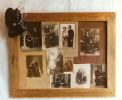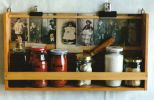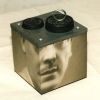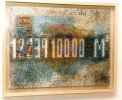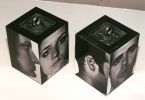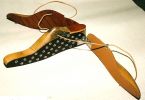Montages
During 1989 and 1990, while she produces the paintings included in the last phase of the third stage- the ‘transitional’ phase- which are already experimental works, tests, Pilar Lara tries also with other supports, techniques and languages. She carries out the first ‘montages’, or combination of objects and photographs, before she starts alternating them with the boxes, the containers for fragments of memory and conscience.
In those first montages, such as ‘Acerico’, ‘Ordinales’ [Ordinals], ‘Gravidez’, ‘Tabla de picar carne’ [Cutting board] and ‘La criva’, the objects frequently appear superimposed on a plane or background, as if the artist was reluctant to abandon the two-dimensional formats, which have been a model for her up until that moment; however, as opposed to what happens in paintings, where frames or even photographs are added to the painting support, in these other works, the background is still painted and created by the artist and is not more important than the objects, but forms a ‘whole’ with them, a small semantic universe revolving around a message. In the boxes, that microcosm will take shape in the intimate space of the container. Although the linguistic code will be more or less the same in both cases, there is no doubt that the boxes will represent a change in perspective, the definitive break with any link to the previous creative phase, painting and its system of representation, and above all, the discovery of her own medium, nontransferable and very close to the context of use of the objects, a ‘natural’ and harmonious medium, with all the intimacy and routines the objects also imply. Pilar Lara, as any other ‘objectual’ artist, manipulates reality based on its own nature, and creates a new one out of pieces of many realities, which have in common their ability to interact significantly according to bonds that are only captured by the creator’s- or in this case ‘recreator's’- subjectivity, who makes us deliberately turn our look towards our environment, our reality, our memory, our legacy, our conscience, revealing their secrets, their hidden drives, their contradictions, the invisible plot of our lives…The artist thus becomes a ‘demiurge'.
Montages and boxes are integrated, as soon as they take shape, into the particular ‘museum’ of Pilar Lara. Each work is a window, a showcase, a small system in which the objects, according to the techniques of museography, interact through associated codes until they form a meaningful message. They are the lexemes of a sentence; and the different sentences construct a coherent and passionate story, a journey through our inner everyday reality. A form of expression that, in the artistic field, is remotely related to ancestors like Cornell.
The themes of the montages are similar to those addressed in the boxes: the female condition- as in ‘Gravidez’ and ‘Anónimo’-, the building of lives- as in ‘Ordinales’ and ‘Fases’ [Phases]-, the destruction of those same innocent lives in the whirlwind of wars- as in ‘Tabla de picar carne’, ‘Sin título’ [Untitled], ‘Tiro al blanco’ [Target shooting] and ‘Ingredientes para el chorizo’-, the concern about the environment- as in ‘CO2’-, and the double standard of the religious institutions- as in ‘Acerico’ and ‘Óbolo’ [Peter’s Pence]-.
At the beginning of this new stage, Pilar Lara’s participation in the Talleres del Arte Actual [Contemporary Art Workshops] at the Círculo de Bellas Artes was without a doubt a crucial influence in the creation of this new language. The first workshop was led by Isidoro Valcárcel in 1990- she prepared ‘Fin de semana’ [Weekend]- and the second one by Ian Wallace in 1992- she directly produced an action rather than a work-. The discussions held after that date with Isidoro, the master of the purest conceptual art around here, with whom she established an enriching friendship, certainly helped her to guide her following steps along this path. It also helped the boost given by the Ciudad de Alcalá award from the Fundación Colegio del Rey for one of her first works in this stage- ‘Sin Titulo’-, and the celebration of the corresponding solo exhibition two years later at the Capilla del Oidor.
The work she did in the workshops at the Círculo resulted in the need to produce a large size work, an installation, in the room for each of her exhibitions, a specific and temporary work, significantly linked to the place and the moment. She displayed this at the Capilla del Oidor, where she presented ‘Lavatorio’ [Wash basin’], an altar made of bars of soap and symbolically located in the chapel’s baptistery. And she repeated in the individual exhibit that concludes this first phase of the fourth stage, the one celebrated just before Christmas in 1995, at the Minerva gallery of the Círculo de Bellas Artes, where she decorated a Christmas tree with artillery shell casings- ‘Reciclaje para la paz nº3’ [Recycling for peace no.3]- a striking and ironic image.
In this exhibition, she dared to present a text drafted by herself, printed on a folded leaflet handed to all visitors. There, she expressed in a more explicit way the reflections that generated the exhibited works, apparently disjointed concerns but that, under the eyes of Pilar, became the symptoms of the same ‘disease’: the collective madness of the human being. The text put all of them together, and showed how the artist produced her works as part of a story, and her exhibitions, as the book in which she collected those chapters to form a coherent plot, a visual plea. For this reason, she preferred to wait and finish the frieze before it came out, and she also preferred to exhibit only when she felt that the work was mature, completed and closed. On this occasion- the exhibition at the Círculo- the themes were the mysteries of the human mind- grouped primarily in a series of boxes, although also in ‘El peso de las ideas no.1’ [The weight of the ideas no. 1], which has its parallel in ‘El peso de las ideas no.2’ [The weight of the ideas no. 2]-; again the injustice of wars that, by that time and still today, devastate the face of the earth- reflected on the tree, ‘Campana para la paz’ [Bell for peace] and on a series of games too-; and also the destruction of nature caused by the greed of the human being- showed in works like ‘España física 1994’ [Spain physical map 1994] and ‘España física 1995’ [Spain physical map 1995]-.
That text began: ‘The human brain weighs about one and a half kilos, contains about one hundred billion neurons (a huge number, in the same order of magnitude as the number of stars in the Milky Way), connected in an intricate and specific way so that memory, sight, knowledge, thought, conscience and other mental abilities are allowed. The assassination of the president of Rwanda unleashed the war between Hutus and Tutsis: a million people dead. Goma becomes a refuge for survivors. Every month hundreds of people die at the refugee camps. The effects of fires in 1994. From January 1st to October 2nd, 405.082 hectares have been burnt. It is the most terrible year regarding burnt areas.
Two years later, in 1999, ‘Restaño’, a new ‘montage’ by Pilar Lara produced in 1997 and semantically linked to the works she is already doing at that moment, such as large format soldiers and the series ‘La mujer anónima’, was awarded the VI Certamen Cultural de la Fundación del Fútbol Profesional [6th Professional Football Foundation Cultural Contest] prize.













